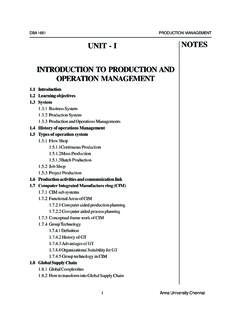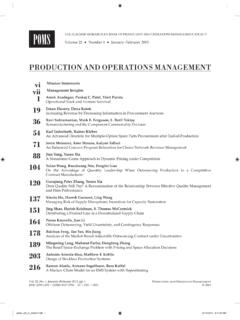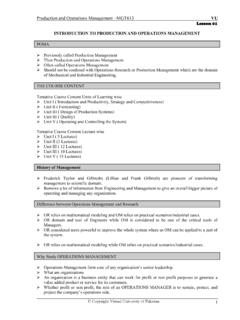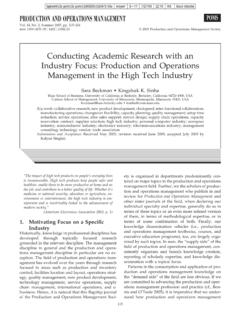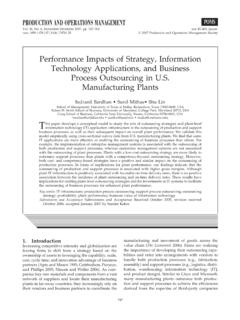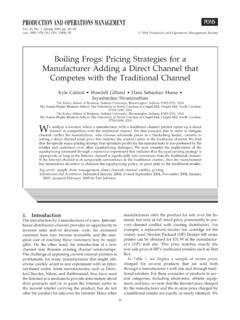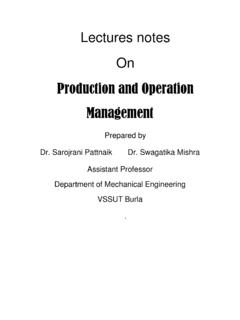Transcription of PRODUCTION AND OPERATIONS MANAGEMENT
1 Performance Improvement Pathsin the Airline Industry:Linking Trade-offs to Asset FrontiersMichael A. Lapre Gary D. ScudderOwen Graduate School of MANAGEMENT , Vanderbilt University, 401 21stAvenue South,Nashville, Tennessee 37203, articles have been written during the past few years examining performance improvementpaths and various forms of efficiency frontiers in OPERATIONS strategy. These articles focus primarilyon defining and describing these frontiers and raise questions concerning how to improve OPERATIONS . Inthis paper, we provide one of the first empirical studies aimed at validating these earlier studies. Usinga database on the 10 largest airlines for a period of 11 years, we test and validate some of the modelspresented in the OPERATIONS literature. The 10 major airlines are separated into 2 groups for analysis:geographic specialists and geographic generalists.
2 Our analysis shows that better performing airlines (interms of cost-quality position) in both groups confirm the predictions of the sand cone model whenoperating further away from their asset frontiers, although trade-offs do occur when operating close toasset words: OPERATIONS strategy; performance improvement paths; trade-offs; asset frontiers; logisticregression; services; strategySubmissions and Acceptance: Received August 2002; revision received February 2003; accepted May 2003by Robert IntroductionDuring the past 20 years, some of the fundamentalthinking in the OPERATIONS MANAGEMENT field haschanged dramatically. In the early 1980s, operationsmanagers and OPERATIONS MANAGEMENT courses ad-dressed trade-offs between OPERATIONS priorities.
3 Inthe late 1980s and early 1990s, the discussion turned tosequences of capabilities improvements and the pos-sibility that trade-offs actually no longer existed inoperations. In 1996, in a special issue ofProduction andOperations MANAGEMENT (see Skinner 1996a), Clark(1996) and Hayes and Pisano (1996) introduced thenotion of performance improvement paths. This paperpresents one of the first longitudinal empirical analy-ses of performance improvement paths, using qualityand cost data from the airline plot performance improvement paths for the 10largest airlines over a period of 11 years. The 10major airlines are separated into 2 subgroups: geo-graphic specialists and geographic generalists. In bothsubgroups, we find that airlines operating close totheir asset frontiers faced initial trade-offs, whereasairlines operating farther away from their asset fron-tiers were able to improve quality and cost simulta-neously.
4 Logistic regression estimates confirm ouranalysis of the performance improvement path also find that lasting quality improvements pre-cede lasting cost this paper, we first discuss some of the evolutionof the OPERATIONS MANAGEMENT community s view oftrade-offs, mass customization, and improvementpaths. Next, we describe our data and plan of , we present and discuss results concerninghow these data either support or refute some of thetheories discussed Trade-off ModelsFor many years, OPERATIONS managers focused on fourprimary objectives: cost, quality, flexibility, and deliv-ery. In the 1970s and early 1980s, the relationshipsPOMSPRODUCTION AND OPERATIONS MANAGEMENTVol. 13, No. 2, Summer 2004, pp. 123 134issn1059-1478 04 1302 123$ 2004 PRODUCTION and OPERATIONS MANAGEMENT Society123between them were typically described as pure trade-offs.
5 As one cartoonist put it, I have low cost or highquality. Which do you want? If one desired very highquality, then the expectation was that this could onlybe achieved at high cost (and vice versa). Models weredeveloped to calculate the optimal number of de-fects desired in a process ( , Fine 1986).If one desired rapid delivery, this could only beachieved through the maintenance of high levels offinished goods inventory. The existence of this inven-tory precluded anyflexibility in the OPERATIONS . If acustomer desired something which was non-standard,requiringflexible OPERATIONS , the penalty was typicallydelayed shipment. Of course,flexibility was a simplerconcept at that point in time as well. In today s envi-ronment, we deal with numerous types offlexibility(see Gerwin 1993 or Upton 1994).
6 This fundamental view of trade-offs was challengedby Ferdows and De Meyer (1990) when they intro-duced the sand cone model, built on the concept ofcumulative capabilities. Based on empirical evidence,this model postulated that there was a sequence inwhich OPERATIONS objectives should be achieved. Thesequence they presented began with quality andended with cost, withflexibility and delivery in be-tween. Their fundamental result was that operationsshould have a good base of high qualityfirst and, fromthat, expand into improving the other OPERATIONS ob-jectives, with cost last. Since its introduction, thismodel has been examined in other settings to deter-mine its validity (see, , Roth 1996 and Noble 1995).While these researchers and many others found sup-port for the sand cone model, others found evidencewhich was contrary to it.
7 For a complete review ofresearch on the sand cone model, see Scudder (2001).As OPERATIONS technologies advanced, the concept oftrade-offs was further challenged. Mass customiza-tion, where a customer could haveflexibility, rapiddelivery, good quality, and reasonable cost was pro-posed by Pine (1993). Distinctions were also madebetween short-term and long-term trade-offs (St. Johnand Young 1992). OPERATIONS MANAGEMENT textbooksbegan eliminating discussions of trade-offs betweenthe OPERATIONS objectives. But, as we neared the latterhalf of the 1990s, more research emerged re-examiningthe need for trade-offs in OPERATIONS (Skinner 1996b,1996c). Most recently, Safizadeh, Ritzman, and Mallick(2000) found trade-offs between some of the opera-tions capabilities, but not all of them.
8 Boyer and Lewis(2002) examined how manufacturingfirms that haverecently implemented advanced manufacturing tech-nologies view competitive priorities. Their results in-dicate that trade-offs still do exist, but some of thedifferences are more subtle than in earlier the midst of the trade-off discussion, Porter(1996) re-emerged on the strategy front describingproductivity frontiers. He makes the point thatfirmsfarther from their productivity frontiers do not en-counter trade-offs and are able to simultaneously im-prove on multiple performance measures. However,asfirms improve their performance and move closerto the frontier, trade-offs are required. In his view,firms improve their productivity frontiers by investingin new technologies or the OPERATIONS MANAGEMENT literature, Schmen-ner and Swink (1998) introduce their Theory of Per-formance Frontiers.
9 They introduce the concept of an asset frontier, which is formed by structural choicesmade by a company-investment in plant and equip-ment. They also describe the operating frontier, which is defined by choices MANAGEMENT makes inoperating the plant, the infrastructural choices. Theypoint out thatfirms whose operating frontiers arecloser to the asset frontier are operating under the lawof trade-offs, whilefirms further from the frontieroperate under the laws of cumulative also introduce the concepts of bettering per-formance and improving performance, where theformer refers to improved performance on a betteroperating frontier (higher performance, lower cost),while the latter refers to moving toward an existingoperating frontier.
10 Vastag (2000) extends their con-cepts to a between-firm analysis where afirm s op-erating frontier can be viewed as a unique resource ofthefirm with the potential to provide a sustainablecompetitive these authors discuss different approaches tounderstanding OPERATIONS trade-offs and performance,they do not explicitly address how one makes theseimprovements. Clark (1996) and Hayes and Pisano(1996) raise the issue of performance improvementpaths. Given an existing operating frontier and a bet-tered operating frontier, howdofirms move from oneto the other? Howshouldthey? If we think about costand quality as our two primary objectives, how shouldafirm improve quality and lower costs? Should im-provementfirst occur on the existing operating fron-tier, where improved quality generally results in in-creased costs (A to B in Figure 1), followed by an effortFigure 1 Performance Improvement PathsLapre and Scudder:Performance Improvement Paths in the Airline Industry124 PRODUCTION and OPERATIONS MANAGEMENT 13(2), pp.


